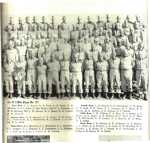Nebraska Army and Air National Guard

By Susan Doak
SW Nebraska
Genealogy Society
MCCOOK, Neb. -- The SWNGS library has a book donated by Sharon Lytle titled, "1854-Nebraska-1954 Army and Air National Guard History." In this first installment, I will cover the initial formation of our state's National Guard and a bit of its history.
Nebraska wasn't even a state when on Dec. 23, 1854, Acting Territorial Governor Cuming proclaimed that citizens of the territory should organize two militia companies, one to be north of the North Platte River and the other south. These companies are considered to be the beginnings of what would become the Nebraska National Guard.
According to this history, the guard was started because of a lame cow and consequently the Nebraska National Guard wears for a Divisional insignia a bovine's skull!
The following story filled in the details. From the aforementioned book: "The lame cow had wandered into the camp of several thousand peaceful Indians, some of whom promptly killed and ate said cow. The lieutenant, with 29 soldiers, marched to the Indian camp and demanded the cow killer be surrendered. The Indians, apparently misunderstanding, hesitated in complying and the soldiers fired a volley. The Indian chief, "The Bear," was killed and the angry Indians promptly killed Lieutenant Gratton and all his men! Thus started the Indian Wars that caused the Nebraska National Guard to be formed."
Omaha claims the origins of the "First Company" organized in 1854 and its intentional use was as a defensive force. In January 1856, the Territorial Legislature passed an act authorizing the Nebraska Volunteer Militia appointing Major General Thayer and Brigade Generals L.L. Bowen and H. P. Downs as First and Second Brigade Commanders. From those appointments, Nebraska City also claims early beginnings from its "Otoe Rifles." Estimates put the beginning militia between 10 and 20 companies.
From 1854 to 1891, the Guard was busy with Indian Defense but five companies were used in 1880 for a riot at the Omaha Smelting Works, plus 445 guardsmen were used in Omaha for the "Camp Dump" strike at the Burlington and Missouri Railroad. In 1891, the Guard was also called up for a political dispute between incumbent Governor Thayer and Governor-Elect Boyd at the state capitol.
Interesting to me was the fact that in 1892, four companies were mobilized, but not sent, to the Hitchcock County Civil War. That reference is a new one to me and certainly worth additional research since the real Civil War was long ended in 1892.
That National Guard continued to address state Peace Time crisis management notably: the south Omaha Packing House Strike (1894), Rushville fire (1909), State Pen riot (1912), Beatrice Easter Sunday Riots (1916), Race Riots in Omaha (1919), and the Nebraska City Packing House Strike (1922), in which the entire National Guard was used.
1935 was a busy year for the Guard as they answered the call to the Republican River Flood, Omaha Street Car Strike and the Scottsbluff "Water Rights" dispute.
While they were busy serving the needs of Nebraska, the Guard was also fighting wars including the real Civil War(1861), War with Spain (1895), Philippine Insurrection (1899), Mexican Border (1916), WWI (1917) and WWII (1944).
All this took place prior to McCook having a National Guard Unit but on March 25, 1948, Company B, 128th Engineer Battalion (Combat) was organized and received its federal recognition. Captain Oswin J. Keifer was the unit's first Commanding Officer, but it is its fifth CO, Captain Victor L. Gonzales, who assumed command on March 15, 1954, that will be the subject of the next installment covering the Nebraska National Guard.
